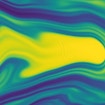Newly Discovered Goliath Galaxies from Early Universe Hint at Massive Dark Matter Trove

A newfound pair of galaxies from the early universe is so massive that it nearly breaks the current understanding of how the cosmos evolved.
The larger of the pair is the most gargantuan galaxy ever seen inhabiting the universe during the first billion years following the Big Bang. The galactic heavyweight contains around 273 billion suns’ worth of gas and dust, researchers estimate in the December 6 issue of Nature. The smaller galaxy is no lightweight either, comprising roughly 40 billion solar masses of gas and dust.
“Either of these galaxies on its own would be extreme, and here you have two of them together,” study co-author Chris Hayward, an associate research scientist at the Center for Computational Astrophysics at the Flatiron Institute in New York City.
Further, two galactic giants in such proximity suggest the presence of an enveloping halo of dark matter clocking in at more than 1 trillion times the mass of the sun. Such structures began as small variations in the density of the cosmos during the expansion following the Big Bang. Gravity caused the relatively dense regions to attract and accumulate more and more material over time — eventually accruing larger and larger stockpiles of both ordinary and dark matter.
The vast amount of matter gathered around the two newly discovered galaxies nearly threatened to smash the current understanding of the universe’s formation. Using the prevailing model of how the universe began and evolved, scientists can estimate just how big structures of this type could be at any given stage of the universe’s evolution. Their calculations showed that at the point in time these galaxies existed and are observed, less than 800 million years after the Big Bang, the galaxies and their dark matter halo were among the most massive structures that the current model would tolerate. An equally extreme structure in the present-day universe would contain 10,000 trillion suns’ worth of material.
“This is really pushing the limits of just how massive a dark matter halo can be at this time in the universe,” Hayward says. “This is one of the rarest and most extreme clumps of dark matter in the universe.”
“There are probably just a handful of objects like this in the whole sky,” says study lead author Dan Marrone, an astrophysicist at the University of Arizona in Tucson. “We’re lucky to have found it.”
Marrone, Hayward and colleagues weren’t originally hunting for giants. They were getting a closer look at light sources spotted by the South Pole Telescope in Antarctica. That telescope surveyed around six percent of the sky, but with relatively coarse resolution.
One of the surveyed sources is much further away from Earth than the others. The light from that source took around 13 billion years to reach Earth, implying that the source appears like it did when the universe was young. But scientists were unsure about the mass and brightness of the distant source because a galaxy is in the way. That in-between galaxy’s strong gravity acts like a lens, bending the path of the incoming light and magnifying the source. Scientists didn’t know if the source was heavily magnified and tiny, or lightly magnified and massive.
Based on modeling of the foreground galaxy and observations made by the Atacama Large Millimeter/submillimeter Array in Chile, the researchers calculated that the mysterious light source is only lightly magnified, and therefore big. Hayward says that the source is so massive that he initially worried that the calculations were wrong.
Further study of the incoming light revealed that the source is two colossal galaxies merging.
Based on the amount of gas in the two galaxies and the typical ratio of dark to ordinary matter in galaxies, the researchers estimated the extent of the dark matter halo containing the two galaxies. The halo’s estimated mass of 1 trillion times the sun’s mass is conservative, Hayward says, and the actual number may be larger.
The colossal collection of dark and ordinary matter isn’t just a record-setting curiosity, Marrone says. The merging galaxies will now serve as a testbed for astronomers to study how massive, star-forming galaxies evolved during the earliest stages of the universe. “There’s still more work to do,” he says.


